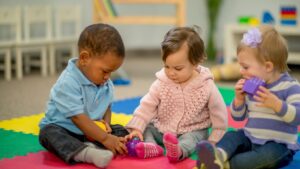Stepping into the vibrant world of preschool is a significant milestone for little ones. It’s a place where children’s curiosity is nurtured, their minds are stimulated, and their social skills are fine-tuned. This article delves into the compelling universe of first years preschool, a critical phase in a child’s educational journey.
From understanding the importance of this early learning stage to exploring what makes a preschool program effective, we’ll guide you through the fascinating facets of first years preschool. Whether you’re a parent seeking the best for your child, or an educator aiming to enhance your teaching strategies, this article is your go-to resource. So, let’s embark on this enlightening journey together, uncovering the magic and importance of first years preschool.
First Years Preschool
Diving deeper into a child’s journey of knowledge absorption, First Years Preschool gets the spotlight. This section magnifies the elements that make these initial years significant, starting from the foundational philosophies to curricular elements to keep children engaged and developing.
The Philosophy Behind Early Childhood Education
 The philosophy behind early childhood education paves the path for growth. Building on the innate curiosity in children, it offers a learning-rich environment, fostering a love for discovery. Certain philosophies, like Montessori and Reggio Emilia, advocate for child-led learning. They stress children’s development at their own pace, in order to maximize potential.
The philosophy behind early childhood education paves the path for growth. Building on the innate curiosity in children, it offers a learning-rich environment, fostering a love for discovery. Certain philosophies, like Montessori and Reggio Emilia, advocate for child-led learning. They stress children’s development at their own pace, in order to maximize potential.
Specific philosophies also emphasize social interaction. Using the HighScope philosophy as an example, it promotes active learning through direct experiences with people and objects. By focusing on concepts such as responsibility, decision-making, and teamwork, the classroom becomes more than an educational globule – it becomes a microcosm of society. As such, children learn to navigate complex social dilemmas while they develop cognitively.
A Look at Curricular Foundations
Taking a glimpse at curricular foundations reveals engaging, multi-faceted activities in play. A focus lies on language foundation, with activities around reading, writing, and listening skills. Phonics-based reading methodologies aid children in piecing sounds together, forming words and sentences.
Another cornerstone of curriculum is mathematic cognition. Through enjoyable games and activities, preschools instill fundamental concepts of number recognition, counting, and shapes. Science too becomes a part of these early learning years, peeking at the world with a curious lens.
The Environment at First Years Preschool
The atmosphere in any educational institution, especially preschools, affects its students’ learning abilities. Children, in their early years, are extremely receptive. Hence, the environment they’re exposed to significantly influences their cognitive and social development.
Classroom Dynamics and Setup
 Classroom dynamics greatly impact a child’s learning. At First Years Preschool, classrooms are designed to engage students actively, ensuring maximum learning. Well-structured classrooms foster better concentration and reduce distractions, equating to improved comprehension abilities for children. Spacious classrooms, equipped with easy-to-access, child-friendly furniture, form the baseline. Examples include chairs and tables of suitable height, low-level shelves, and soft area rugs that invite reading or quiet conversations.
Classroom dynamics greatly impact a child’s learning. At First Years Preschool, classrooms are designed to engage students actively, ensuring maximum learning. Well-structured classrooms foster better concentration and reduce distractions, equating to improved comprehension abilities for children. Spacious classrooms, equipped with easy-to-access, child-friendly furniture, form the baseline. Examples include chairs and tables of suitable height, low-level shelves, and soft area rugs that invite reading or quiet conversations.
Pedagogical resources like educational toys, activity kits, and books are prominent fixtures in such classrooms. A literacy-rich surrounding stimulates language and cognitive skills, fostering learning through books, labels, and teacher-made materials. Additionally, bulletin boards displaying children’s work acknowledge their creativity and provide tangible examples of academic progress.
An open floor layout that promotes group activities, like circle time and free play, encourages a sense of community among children. It promotes social interaction, fostering teamwork. Children learn vital life skills like taking turns, sharing, and respecting others’ space in this setup. It’s an ideal learning environment that marries both education and play, thus allowing children to learn without the dread of monotony.
Outdoor and Play Facilities
Outdoor spaces also play a significant role in a preschool setup. First Years Preschool understands the significance of structured play, evidenced by their expansive and inviting outdoor facilities including, play fields and playgrounds with a wide variety of play equipment.
Age-appropriate play equipment like swings, slides, seesaws, sand play areas and gardening corners, enhance a child’s coordination and motor skills. These safety-first facilities provide children with opportunities for physical activity, essential for their gross motor skills development.
Frequent interaction with nature also helps children understand and appreciate the world around them. Activities such as planting, picking leaves or observing insects can act as practical applications of classroom learning that enlighten a child’s understanding of science and nature.
Structured play, combined with open-ended exploration of the environment in First Years Preschool, enriches the learning experience. It caters to children’s curiosity, creating a holistic educational environment which investigates the balance between play, learning and fun.

